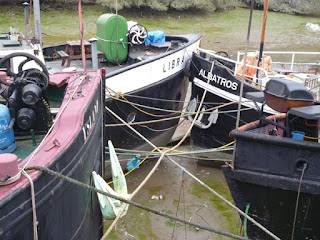My favourite section so far on the current piece of work on 'Reading a Paint Surface' at City Lit. I have strict instructions no matter what else I alter to leave this alone. The earlier exercises paid off - the layers and textures that have accumulated are so subtle yet interesting and I love the hints of unexpected colours at the edges . Coloured grounds rock!!
Arrived at the classroom yesterday to find easels with enormous boards (A0) set up, larger than I could lift ( love the accidental marks) . The idea was to have 2 paintings going at the same time, side by side , using different methods on each. Some people started 2 new paintings and a few besides me were continuing with one we'd started last week
Having worked from a photo upside down last time, I now was working on it sideways so it would fit on the board, then put a drippy green cast acrylic ground on a second piece of A1 paper and for my subject was zooming in on the middle section.
Once dried I added some areas of orange underpainting that had caught my attention in the photo
Over the day , I built up layers of oil paint glazes - I particularly like the section below. It will need a lot of work next week concentrating on the negative shapes between the boats. I might work on it upside down as well - it's getting a bit 'boaty' rather than concentrating on the shapes. It's working title is 'Green Libra' ( the name of the boat) and Tony's suggestion last thing was to put on a layer the same colour as the brushed over lettering and work into that next week.
Meanwhile my first job on 'Red Libra' was to knock back the background with some paler glazes - once dried the orange-red ground was too prominent . In various critiques everyone loves the middle section and the implied shapes of the tops of the boats so that is being left but the dark areas top right are too dominant.
Another critique, pairing up with another student , this area is still not working so suggestion was to return to source photos - the boat wasn't in the right position.
Much better now I've corrected it and I'm liking the remainder of the shape that was left from before - this is where the responding to the painting itself is beginning to kick in.
One other criticism was the need to vary the brush marks in different areas of the paintings. This week I was really struggling with the brushes provided - next time I'll be bringing my own in!
We had an inspector observing the class - it was a bit disconcerting as she listened into our conversations ( she didn't know anything about painting). She did like my colours though, especially the purple.
Very tired when I got home as besides standing at the easel most of the day, trains were delayed because of flooding trains and they stopped people getting on the platform as they were getting overcrowded . There was then a last minute dash for the train and I had to stand until Rochester. Getting off at Faversham found Ian had been in the same carriage!! ( I did ring his mobile but he hardly ever has it on).























































